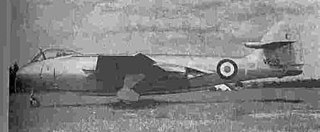
The HFB 320 Hansa Jet is a twin-engine, ten-seat business jet that was designed and produced by German aircraft manufacturer Hamburger Flugzeugbau between 1964 and 1973. The most recognisable and unconventional feature of the aircraft is its forward-swept wing.

The Douglas D-558-2 Skyrocket is a rocket and jet-powered research supersonic aircraft built by the Douglas Aircraft Company for the United States Navy. On 20 November 1953, shortly before the 50th anniversary of powered flight, Scott Crossfield piloted the Skyrocket to Mach 2, or more than 1,290 mph (2076 km/h), the first time an aircraft had exceeded twice the speed of sound.

The Douglas F5D Skylancer is a development of the F4D Skyray jet fighter for the United States Navy. Starting out as the F4D-2N, an all-weather version of the Skyray, the design was soon modified to take full advantage of the extra thrust of the Pratt & Whitney J57 eventually fitted to the Skyray instead of the Westinghouse J40 originally planned.

The Aerfer Sagittario 2 was a prototype all-metal single-seat lightweight fighter aircraft built in Italy by Aerfer, intended to serve as an interceptor or light tactical support aircraft. First flown in 1956, it became the first Italian aircraft to break the sound barrier in controlled flight when it reached Mach 1.1 during a dive from 13,725 m (45,000 ft).

The IAI Westwind is a business jet initially produced by Aero Commander as the 1121 Jet Commander. Powered by twin GE CJ610 turbojets, it first flew on January 27, 1963, and received its type certification on November 4, 1964, before the first delivery. The program was bought by Israel Aircraft Industries (IAI) in 1968, which stretched it slightly into the 1123 Westwind, and then re-engined it with Garrett TFE731 turbofans into the 1124 Westwind. The 16,800–23,500 lb (7.6–10.7 t) MTOW aircraft can carry up to 8 or 10 passengers, and 442 were produced until 1987.

The Douglas Skystreak was an American single-engine jet research aircraft of the 1940s. It was designed in 1945 by the Douglas Aircraft Company for the U.S. Navy Bureau of Aeronautics, in conjunction with the National Advisory Committee for Aeronautics (NACA). The Skystreak was a turbojet-powered aircraft that took off from the ground under its own power and had unswept flying surfaces.

The Hawker P.1072 was a 1949 experimental British aircraft acting as a test bed for the Armstrong Siddeley Snarler rocket booster engine. It was the prototype Hawker Sea Hawk modified to install the rocket in the tail.

The Piaggio P.166 is an Italian twin-engine pusher-type utility aircraft developed by Piaggio Aero. The aircraft model name was Portofino, and is also known as Albatross in South African military service.

The Soko J-21 Jastreb, referred to as the J-1 Jastreb in some sources, is a Yugoslav single-seat, single-engine, light attack aircraft, designed by the Aeronautical Technical Institute (ATI) and Military Technical Institute (VTI), in Belgrade and manufactured by SOKO in Mostar. Derived from the G-2 Galeb advanced jet trainer and light attack aircraft, it was designed in single-seat ground-attack and two-seat advanced flying/weapon training versions.

The Reggiane Re.2002 Ariete ("Ram") was an Italian fighter-bomber developed during World War II. The aircraft was a further development of the Re.2000, with some of the modifications that already had been introduced in the Re.2001. The aircraft was mainly used by the Regia Aeronautica, but it also saw limited use with the German Luftwaffe, who used it against the French resistance.

The Savoia-Marchetti SM.78 was an Italian bomber/reconnaissance biplane flying boat of the early 1930s.
The Piaggio P.32 was an Italian medium bomber of the late 1930s, produced by Piaggio, and designed by Giovanni Pegna. It was a modern design for its time, but was a failure due to lack of powerplants commensurate with its high wing loading.

The Piaggio P.148 was a 1950s Italian two-seat primary or aerobatic training monoplane designed and built by Piaggio Aero.

The Piaggio P.150 was a 1950s Italian two-seat trainer designed and built by Piaggio to meet an Italian Air Force requirement to replace the North American T-6.

The Fiat G.80 was a military jet trainer designed and produced by the Italian aircraft manufacturer Fiat. It has the distinction of being the first true jet-powered indigenous aircraft to be flown by Italy.
The Viper Aircraft ViperJet is a small homebuilt jet aircraft by Viper Aircraft Corporation. It is a conventional, low-wing monoplane with swept wings and tail and two seats in tandem under a bubble canopy. The jet intakes are located at the sides of the fuselage and the tricycle undercarriage is retractable. Construction throughout is of composite materials.

The FiatG.91Y is an Italian ground-attack and reconnaissance aircraft which first flew in 1966. Although resembling its predecessor, the Fiat G.91, the aircraft was in fact a complete redesign, a major difference being that it was equipped with a new twin-engine configuration, replacing the original single engine.
The Procaer Cobra was a two-seat turbojet powered light aircraft designed and built in Italy and flown in the early 1960s. Only one was completed.
The Eurofly Viper is an Italian ultralight trike, designed and produced by Eurofly Srl of Galliera Veneta. The aircraft is supplied as a complete ready-to-fly-aircraft.
The Viper Aircraft Viperfan was an American homebuilt aircraft that was designed and produced by Viper Aircraft of Kennewick, Washington, introduced in the late 1990s. It was intended to be supplied as a kit for amateur construction, but only one was ever built.

















